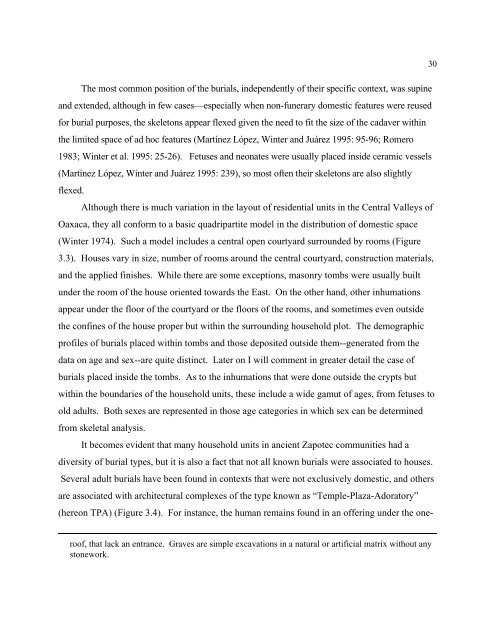You also want an ePaper? Increase the reach of your titles
YUMPU automatically turns print PDFs into web optimized ePapers that Google loves.
The most common position of the burials, independently of their specific context, was supine<br />
and extended, although in few cases—especially when non-funerary domestic features were reused<br />
for burial purposes, the skeletons appear flexed given the need to fit the size of the cadaver within<br />
the limited space of ad hoc features (Martínez López, Winter and Juárez 1995: 95-96; Romero<br />
1983; Winter et al. 1995: 25-26). Fetuses and neonates were usually placed inside ceramic vessels<br />
(Martínez López, Winter and Juárez 1995: 239), so most often their skeletons are also slightly<br />
flexed.<br />
Although there is much variation in the layout of residential units in the Central Valleys of<br />
Oaxaca, they all conform to a basic quadripartite model in the distribution of domestic space<br />
(Winter 1974). Such a model includes a central open courtyard surrounded by rooms (Figure<br />
3.3). Houses vary in size, number of rooms around the central courtyard, construction materials,<br />
and the applied finishes. While there are some exceptions, masonry tombs were usually built<br />
under the room of the house oriented towards the East. On the other hand, other inhumations<br />
appear under the floor of the courtyard or the floors of the rooms, and sometimes even outside<br />
the confines of the house proper but within the surrounding household plot. The demographic<br />
profiles of burials placed within tombs and those deposited outside them--generated from the<br />
data on age and sex--are quite distinct. Later on I will comment in greater detail the case of<br />
burials placed inside the tombs. As to the inhumations that were done outside the crypts but<br />
within the boundaries of the household units, these include a wide gamut of ages, from fetuses to<br />
old adults. Both sexes are represented in those age categories in which sex can be determined<br />
from skeletal analysis.<br />
It becomes evident that many household units in ancient <strong>Zapotec</strong> communities had a<br />
diversity of burial types, but it is also a fact that not all known burials were associated to houses.<br />
Several adult burials have been found in contexts that were not exclusively domestic, and others<br />
are associated with architectural complexes of the type known as “Temple-Plaza-Adoratory”<br />
(hereon TPA) (Figure 3.4). For instance, the human remains found in an offering under the one-<br />
roof, that lack an entrance. Graves are simple excavations in a natural or artificial matrix without any<br />
stonework.<br />
30

















